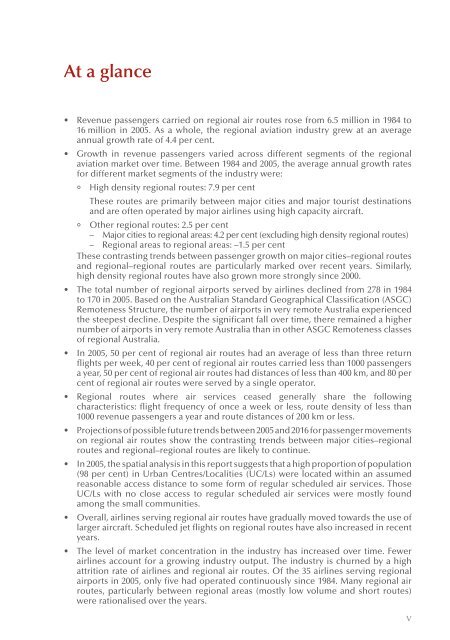PDF: 5191 KB - Bureau of Infrastructure, Transport and Regional ...
PDF: 5191 KB - Bureau of Infrastructure, Transport and Regional ...
PDF: 5191 KB - Bureau of Infrastructure, Transport and Regional ...
- No tags were found...
You also want an ePaper? Increase the reach of your titles
YUMPU automatically turns print PDFs into web optimized ePapers that Google loves.
At a glance• Revenue passengers carried on regional air routes rose from 6.5 million in 1984 to16 million in 2005. As a whole, the regional aviation industry grew at an averageannual growth rate <strong>of</strong> 4.4 per cent.• Growth in revenue passengers varied across different segments <strong>of</strong> the regionalaviation market over time. Between 1984 <strong>and</strong> 2005, the average annual growth ratesfor different market segments <strong>of</strong> the industry were:° High density regional routes: 7.9 per centThese routes are primarily between major cities <strong>and</strong> major tourist destinations<strong>and</strong> are <strong>of</strong>ten operated by major airlines using high capacity aircraft.° Other regional routes: 2.5 per cent– Major cities to regional areas: 4.2 per cent (excluding high density regional routes)– <strong>Regional</strong> areas to regional areas: –1.5 per centThese contrasting trends between passenger growth on major cities–regional routes<strong>and</strong> regional–regional routes are particularly marked over recent years. Similarly,high density regional routes have also grown more strongly since 2000.• The total number <strong>of</strong> regional airports served by airlines declined from 278 in 1984to 170 in 2005. Based on the Australian St<strong>and</strong>ard Geographical Classification (ASGC)Remoteness Structure, the number <strong>of</strong> airports in very remote Australia experiencedthe steepest decline. Despite the significant fall over time, there remained a highernumber <strong>of</strong> airports in very remote Australia than in other ASGC Remoteness classes<strong>of</strong> regional Australia.• In 2005, 50 per cent <strong>of</strong> regional air routes had an average <strong>of</strong> less than three returnflights per week, 40 per cent <strong>of</strong> regional air routes carried less than 1000 passengersa year, 50 per cent <strong>of</strong> regional air routes had distances <strong>of</strong> less than 400 km, <strong>and</strong> 80 percent <strong>of</strong> regional air routes were served by a single operator.• <strong>Regional</strong> routes where air services ceased generally share the followingcharacteristics: flight frequency <strong>of</strong> once a week or less, route density <strong>of</strong> less than1000 revenue passengers a year <strong>and</strong> route distances <strong>of</strong> 200 km or less.• Projections <strong>of</strong> possible future trends between 2005 <strong>and</strong> 2016 for passenger movementson regional air routes show the contrasting trends between major cities–regionalroutes <strong>and</strong> regional–regional routes are likely to continue.• In 2005, the spatial analysis in this report suggests that a high proportion <strong>of</strong> population(98 per cent) in Urban Centres/Localities (UC/Ls) were located within an assumedreasonable access distance to some form <strong>of</strong> regular scheduled air services. ThoseUC/Ls with no close access to regular scheduled air services were mostly foundamong the small communities.• Overall, airlines serving regional air routes have gradually moved towards the use <strong>of</strong>larger aircraft. Scheduled jet flights on regional routes have also increased in recentyears.• The level <strong>of</strong> market concentration in the industry has increased over time. Fewerairlines account for a growing industry output. The industry is churned by a highattrition rate <strong>of</strong> airlines <strong>and</strong> regional air routes. Of the 35 airlines serving regionalairports in 2005, only five had operated continuously since 1984. Many regional airroutes, particularly between regional areas (mostly low volume <strong>and</strong> short routes)were rationalised over the years.v
















